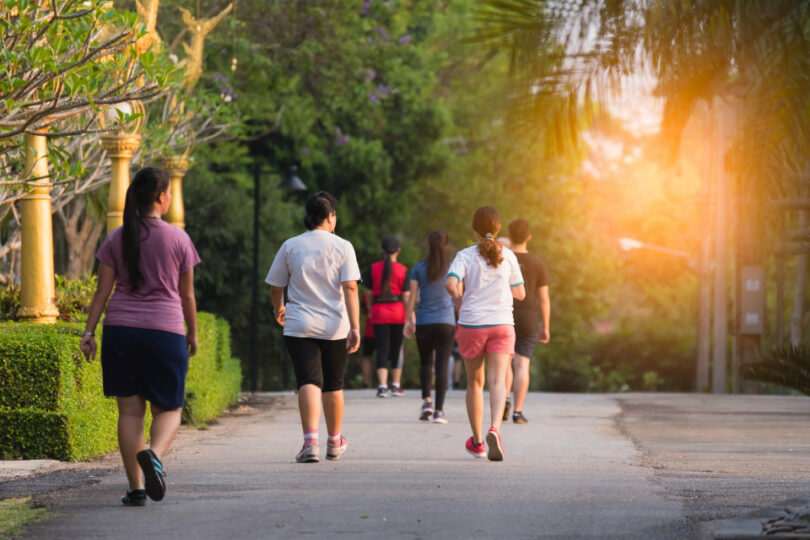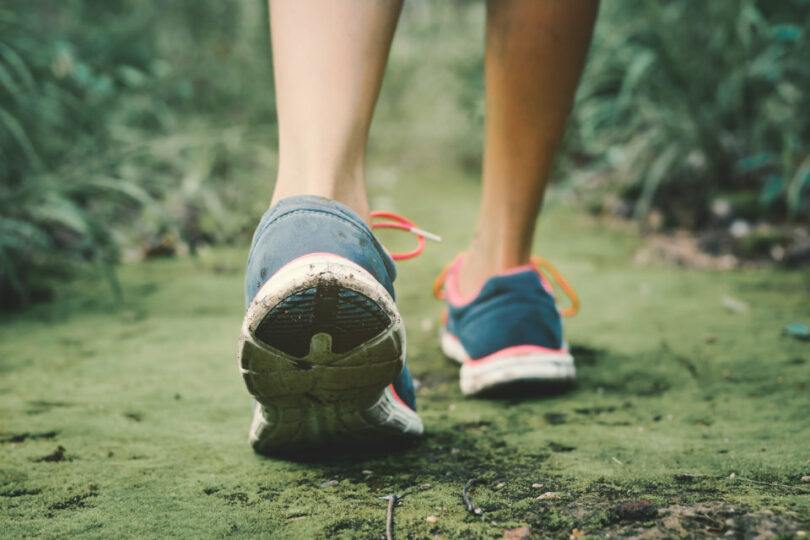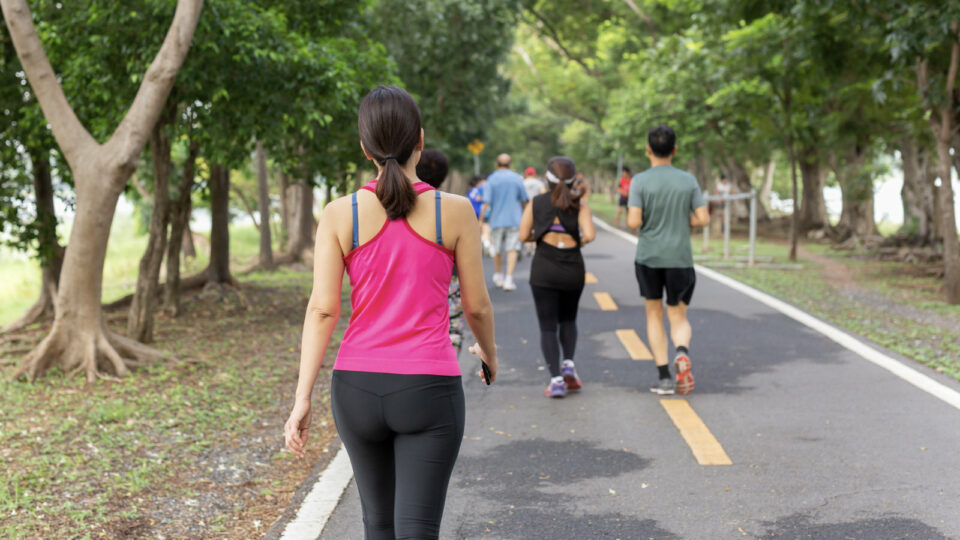In a world constantly seeking radical fitness regimes, the humble act of walking often gets overlooked. However, integrating simple practices like walking 1 mile a day can catalyse profound changes in your health, both physically and mentally.
This accessible activity isn’t just about changing your fitness levels; it’s about revamping your lifestyle, one step at a time.
Table of Contents
The Science Behind Walking
Walking isn’t merely putting one foot in front of the other; it’s a full-body workout that requires coordination, burns calories, and activates various muscle groups.
According to numerous studies, including those published in The American Journal of Clinical Nutrition, walking increases cardiovascular and pulmonary fitness, reduces the risk of heart disease and stroke, and improves conditions such as hypertension, high cholesterol, joint and muscular pain, and diabetes.
Furthermore, walking doesn’t only work your muscles but also enhances mental well-being by releasing endorphins, known as the ‘feel-good’ hormones.
On average, it takes a person about 15 to 20 minutes to walk one mile (approximately 1.6 kilometres) at a moderate pace.
RunSociety
The Benefits of Walking 1 Mile a Day
Physical Health Improvements
Walking 1 mile a day is a manageable way to initiate your journey towards better health. It aids in strengthening the heart, improving muscle strength, and enhancing endurance. It’s also beneficial for joint health — a low-impact activity that can increase strength and flexibility in the surrounding muscles.
Mental Health Benefits
The mental health benefits of walking are just as profound. A regular walking routine can help manage stress, anxiety, and depressive symptoms, creating a sense of calm and well-being. It’s also a great way to boost brainpower, as walking has been linked to improved cognition and reduced risks of cognitive decline.
Weight Management
If you’re looking to manage your weight, walking 1 mile a day can be a great starting point. Paired with a healthy diet, it can contribute to a calorie deficit, promoting steady weight loss.
Enhanced Sleep Quality
An invigorating walk can also lead to a better night’s sleep. Regular walkers often report faster sleep onset and higher-quality sleep, providing the body with the rest it requires to recover and rejuvenate.
Increased Longevity
Walking can add years to your life. Studies have shown that regular, low-intensity exercise like walking can increase life expectancy by reducing risks associated with chronic illnesses.

How to Start a Daily Walking Routine
Tips for Beginners
Starting a new routine can be challenging. Begin with a slow, short walk and gradually increase your pace and distance. Find a comfortable pair of shoes to prevent blisters and sore feet. Remember, consistency is key, even if it means walking a shorter distance each day.
Staying Motivated
Set realistic goals and track your progress with the numerous apps available that monitor steps, distance, and calories burned.
For an innovative twist, consider joining a virtual walk or virtual run at Spacebib. These events not only sharpen your focus on objectives but also immerse you in a global community of walkers and runners, fostering a sense of belonging.
Consider finding a walking buddy or becoming part of a local walking or running group can be incredibly beneficial.
Sharing your journey not only makes the process more enjoyable but also keeps you motivated. Participating in virtual events adds an exciting new dimension to your daily routine, keeping your motivation fresh and alive.
Safety Considerations
When embarking on your daily walking routine, it’s crucial to pay attention to various safety considerations to ensure a positive and healthy experience. First, always stay hydrated, particularly in warm weather, by carrying a water bottle and taking regular sips, even if you don’t feel thirsty.
Planning your route is essential — opt for well-lit areas if your schedule has you walking early in the morning or late in the evening to improve visibility and safety. If your walks are during the day, don’t forget to apply sunscreen to protect your skin from harmful UV rays, and wear protective gear like sunglasses and a hat.
Consider the terrain you’ll be walking on, as well. For most people, a flat or slightly inclined pathway is ideal to start with, especially if you’re new to regular walking. These paths, often found in local parks or walking trails, offer a balance of ease and challenge.
Avoid overly rocky or uneven terrains that could increase your risk of falls or ankle injuries. Over time, as your strength and endurance improve, you might want to introduce more challenging terrains like hills or soft sand to intensify your workout.
Additionally, invest in a good pair of supportive walking shoes to provide proper cushioning and support, which is vital regardless of the terrain but especially if you’re navigating slopes or uneven surfaces. Reflective clothing or a safety vest is advisable for visibility, and consider carrying a mobile phone for emergencies, particularly if you’re walking alone.
Always inform someone about your walking route and the expected return time for an extra layer of safety.
Invest in Good Equipment
Ensuring comfort and preventing potential injuries start with the right gear. Invest in a good pair of walking shoes to provide proper support, and don’t overlook the importance of comfortable attire.
A good walking t-shirt, such as those available from Crossline, can enhance your walking experience by providing breathability and ease of movement, keeping you cool and dry throughout your walks.
Remember, the right equipment can make a significant difference in maintaining your daily walking routine.

What Happens as You Increase Your Daily Miles?
Embarking on the journey of walking isn’t just a one-time decision but an evolving commitment. As you enhance your routine from walking 1 mile a day, each additional mile brings its own set of rewards and challenges.
Here’s a detailed breakdown of the changes your body experiences as you gradually increase your daily walking distance, tailored for those curious about the daily outcomes of each distance walked.
Walking 2 Miles a Day (3.22 Kilometres)
Doubling your effort to walking 2 miles a day can significantly ramp up the health benefits. This moderate-level activity further boosts cardiovascular health, aids in sustainable weight loss, and enhances muscular strength and endurance. This routine aligns with the American Heart Association’s recommendation of 150 minutes of moderate exercise per week.
Walking 3 Miles a Day (4.83 Kilometres)
Upping your routine to walking 3 miles a day presents noticeable changes. This level not only promotes a deeper calorie deficit—facilitating weight management—but also contributes to improved mental clarity and emotional health, thanks to the extended release of endorphins.
Walking 4 Miles a Day (6.44 Kilometres)
At this point, you’re likely to experience enhanced cardiovascular endurance and more significant calorie burning. Walking 4 miles a day can be particularly beneficial for those seeking weight loss or maintenance. The consistency in physical activity can result in improved regulation of blood sugar levels, benefiting those with type 2 diabetes.
Walking 5 Miles a Day (8.05 Kilometres)
Achieving 5 miles a day marks a high level of physical activity. Besides the amplified health benefits like decreased blood pressure and cholesterol levels, it also adds an element of mental toughness and commitment to your routine, cultivating discipline that could permeate other areas of life.
Walking 6 Miles a Day (9.66 Kilometres)
As you progress to walking 6 miles a day, you’ll potentially see an uptick in metabolism. It’s also a milestone for mental health, contributing to enhanced mood and sleep quality, and a reduction in stress and anxiety levels.
Walking 7 Miles a Day (11.27 Kilometres)
This intensity of daily walking can significantly increase your energy expenditure, contributing to substantial weight loss over time. It’s also likely to improve joint and bone health due to the increased activity, though adequate rest and nutrition are crucial at this stage to prevent overuse injuries.
Walking 8 Miles a Day (12.87 Kilometres)
At this advanced stage, you’re likely experiencing optimal cardiovascular benefits, including improved heart health and lung capacity. However, it’s essential to balance this level of activity with appropriate nutrition and hydration.
Walking 9 Miles a Day (14.48 Kilometres)
Consistently walking 9 miles a day could lead to profound improvements in endurance and significant calorie expenditure. It’s critical, though, to listen to your body’s signals, ensuring you’re not overtraining and allowing sufficient time for recovery.
Walking 10 Miles a Day (16.09 Kilometres)
Entering the double digits, walking 10 miles a day is an impressive physical feat that can result in substantial improvements in muscle tone and weight management. The mental health benefits continue to expand, potentially including enhanced self-esteem and lower levels of depression.
Walking 11-12 Miles a Day (17.70- 19.31 Kilometres)
These distances are significant undertakings that require a considerable time investment and physical stamina. While the health benefits continue to accumulate, it’s vital to be mindful of the body’s nutritional needs and recovery time to prevent burnout.
Walking 13.1 Miles a Day (21.08 Kilometres)
At half-marathon distance, the commitment to walking 13.1 miles a day requires not only physical endurance but a strong mental resolve. Such an achievement may provide a remarkable sense of accomplishment and mental fortitude but should be pursued with caution to prevent injury.
Walking 26.2 Miles a Day (42.16 Kilometres)
A full marathon every day is an extreme physical challenge that few undertake. While it might offer the highest level of endurance training and calorie expenditure, walking 26.2 miles a day necessitates professional guidance to ensure it’s done safely and with proper health considerations.
Start Walking 1 Mile a Day First
Embracing the practice of walking daily offers a plethora of health benefits and can be a gateway to a more active lifestyle. Starting with walking 1 mile a day creates a foundation that encourages healthier habits, potentially leading to a happier, more fulfilled life.
It’s not about the distance or speed; it’s about making a commitment to your health, one step at a time. Remember, the journey of a thousand miles begins with a single step. So, why not start today?
What are the health benefits of walking 1 mile a day?
Walking 1 mile a day aids in weight loss, improves heart health, enhances mood, boosts energy levels, and promotes better sleep, among other health benefits.
How many calories does walking 1 mile a day burn?
On average, a person burns about 100 calories walking 1 mile, depending on individual factors like weight, pace, and terrain.
Can walking 1 mile a day help me lose weight?
Yes, walking 1 mile a day can contribute to weight loss by burning extra calories and enhancing metabolic rate, especially when combined with a healthy diet.
How long does it take to see results from walking 1 mile a day?
While individual results may vary, most people notice positive changes in mood and energy immediately, with physical benefits like weight loss becoming noticeable in a few weeks.
Is walking 1 mile a day enough for physical fitness?
While walking 1 mile a day is a positive step towards better health, combining it with regular varied exercise and a balanced diet is ideal for overall physical fitness.
What happens if I increase my walking to 2 miles a day or more?
Increasing your walking distance can amplify the benefits, including more significant weight management, improved stamina, stronger muscles and bones, and greater overall health improvements.
Can I experience joint pain from walking 1 mile a day?
Most people do not experience joint pain from walking 1 mile a day. However, ensure you have proper footwear, maintain a comfortable pace, and avoid harsh terrains to reduce any potential strain.
Is it better to walk 1 mile a day or run for less distance?
Walking 1 mile a day is less strenuous on the body and may be more sustainable for some individuals, whereas running burns more calories but can be harder on joints. Both have unique health benefits, and the choice depends on individual preferences, fitness levels, and health goals.





